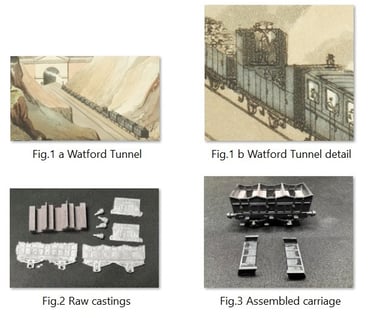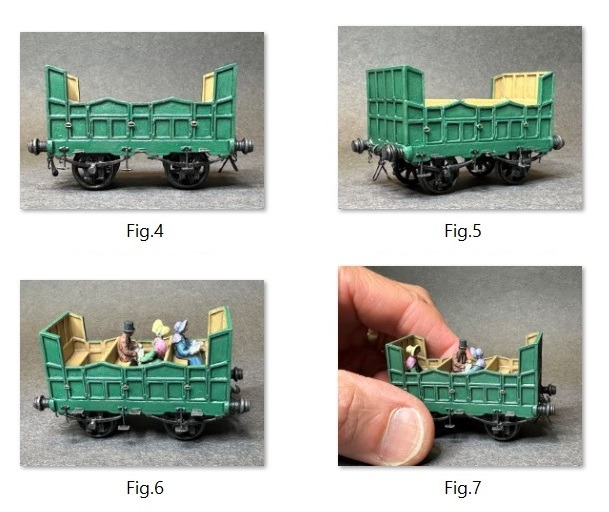A curious variant on the early 'open'
A early carriage, verified by the minutes and a TT Bury print
8/9/20234 min read


I’ve long been entertained and intrigued by depictions of early railways of the 1830s and ‘40s. The period was marked by significant political and social change, the technology of the new iron roads symbolised these changes more than anything and the railway companies knew it. From the opening of the Liverpool & Manchester Railway onwards, artists such as Isaac Shaw, John Cooke Bourne, Thomas Talbot Bury and many others recorded what they saw, creating images that sought to commemorate and impress. From these illustrations lithographic prints were produced and distributed in quantity, in a way a form of propaganda, promoting the grandeur and unprecedented architectural and engineering achievements of the railways whilst at the same time demonstrating how harmoniously they would sit within the landscape, showing just how marvellous (and safe) it would be to travel by train.
The detail and accuracy of many images is praiseworthy, Shaw was a skilled engraver, Bourne a talented artist and Bury a noted architect however, some images must be taken with a full chip shop’s worth of salt, and a few would not look out of place hanging in a gallery of work by Salvador Dali. Therefore, one must never rely on such pictures as a clear window into the past but in the absence of photographs or files full of detailed and fully dimensioned drawings, they are all we have.
Fig. 1. Detail of ‘The entrance to the tunnel at Watford’ by T. T. Bury, engraved by N. Fielding, published by Ackermann, London, 1837.
The subject of this article is an oddity I noticed many years ago in a charming painting by T. T. Bury showing an impressive cutting on the London & Birmingham Railway. The little engine processes gaily towards the Watford tunnel entrance blissfully unaware that it is on the wrong line pulling eight open carriages, little more than trucks with seats, four enclosed second- and first-class carriages bringing up the rear. Sandwiched between these is one carriage which appears to be another open third but with raised full-height ends. Not only that, two passengers, apparently a couple, stand at seat back height looking forward down the train to the locomotive and the approaching tunnel. Trains in this period seldom reached speeds in excess of 25mph or so, but even at this pace standing on the end of the carriage would seem to be an extremely hazardous thing to do. Momentary loss of footing could result in serious injury, even death. Surely a flight of fancy on the part of the usually reliable artist I thought - but no. Buried in the London & Birmingham Railway minute books held at the National Archives is a short sentence that goes a long way to confirm that Thomas Talbot Bury was not pulling our legs. Dated 17th April 1837, minute 81 reads ‘Ordered - that Mr Bagster be authorised to give additional height to the ends of one or more of the third class carriages.’ It seems that this instruction was indeed carried out and remarkably Bury recorded one of these rare vehicles. Those familiar with my modelling will know that this is all the evidence I need to produce a model and it proved to be more straightforward that one might think.
After the opening of the London & Birmingham Railway, the board were left with a significant number of open carriages used initially to show-off the line but really only suitable for a third-class fare. Given that they had no intention of carrying third-class passengers something useful had to be done with them. Thankfully, they were sturdy enough to be converted into covered second-class carriages with the addition of brakes, full height ends and roofs whilst others formed the basis for entirely enclosed carriages. Our curious carriage would appear to be a half-way house for the daredevil traveller. In my quest for a good variety of London & Birmingham carriages I had already produced a cast white metal ‘kit’ for the open carriage based on drawings published by Samuel Brees in his ‘Railway Practice’ of 1842.
Fig.2. The raw castings for the London & Birmingham open third awaiting cleaning and assembly
The basic carriage was put together in the usual way, soldered construction with etched details and a set of resin cast seats which simply slot in place. Once completed, the carriage was thoroughly cleaned and given a coat of primer. The end extensions were then fabricated from styrene sheet and strip, and carefully glued in place. I decided that Bury’s suggestion that the two passengers were standing at the height of the seat back must be slightly incorrect. To do this would have required a substantial shelf at this height which would then prevent anyone from actually sitting on the end seats (unless the shelf folded up) and in fact standing on the seat itself would be sufficient to see over the carriage end and satisfy any burning desire to have one’s top hat blown off.
Fig.3. The assembled carriage in black undercoat with the end extensions made from black styrene.
The building of this curiosity took a few evenings work but the novelty of the finished carriage together with the point that it brings to life an otherwise forgotten or even unbelievable detail from the early days of railway travel was well worth it. As always, I am very grateful to Tom Nicholls for finding this little gem of information in the archives and providing the excuse I needed
Figs.4-7 The completed and painted carriage just requiring a couple of standing passengers with a ‘Devil-may-care’ attitude towards personal safety.


